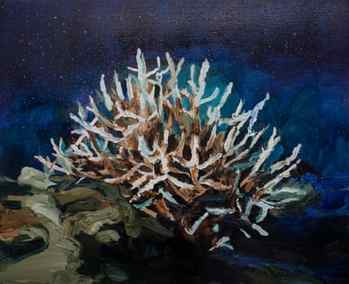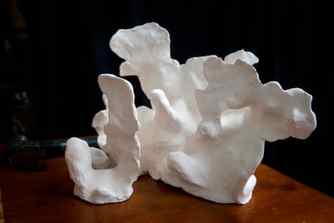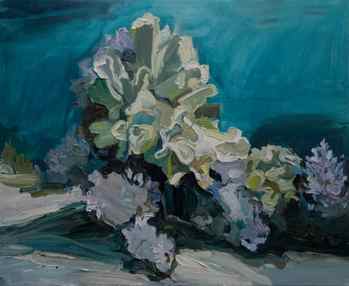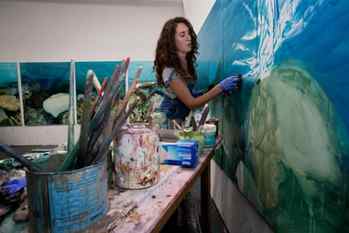23 August It is particularly obvious today that the staghorn corals are nearly completely wiped out. I see some struggling and looking almost dead, which just highlights how … common the algae-covered skeletons are and how beautiful it would have been before. I find a little bright purple stag horn coral and make sure I get a good photo of it so that I can draw it later. As I swim I think about how I’m going to paint and draw things the whole time. I don’t want to only paint dead or dying coral, I want to paint the survivors, too.
How to capture coral reef in a painting
Use Phone to See This Art on Wall

View Art on your Wall
The artwork develops into an infinite variety of shapes into an abstract composition. The coral reef was the main inspiration behind this creation.
About artist
Authenticity
We guarantee you the authenticity of this piece with a certificate of authenticity delivered with every piece on our website. There are a few exceptions with some of the artworks from the Digital and Mixed Media category. It is always mentioned whether it is print. You will receive a certificate mentioning the exact amount artists made and what number of prints is your artwork.
Shipping, Delivery & Returns
The shipping of the art pieces is on average between 7-14 days to arrive in your home. Shipping days may vary depending on the country where the art piece is located and your shipping address. You will have more precise shipping details during checkout. Once the art piece is shipped, you will receive a tracking code to follow the delivery to your home.
Not convinced by the art piece you received? No problem, we have a 14-day return policy. Send us back the undamaged art piece within 14 days after you received it, and we will give you a full refund.
If you have more questions with shipping, delivery, and return please check the FAQ’s page.
Renting the Artwork
Do you like this piece, but you do not want to buy it yet? We offer renting options for 3, 4, or 6 months for you to try it in your home and see if it is the right fit for you. If you are interested in this option, feel free to contact us.
Framing & Hanging
Do you love this art piece, but need information on how to take care of it? Our guide will help you learn how to frame, hang and take care of this art piece to keep it in good condition. Check our guide here.
FAQs
Do you have a question, and did not find the answer here? Check our FAQ’s page to find it.
If you did not find it there, you can send your question and our experts will gladly answer it.
More About the Artist
Martin is a creative artist who creates colorful artworks that can lift the mood in any area. His work is inspired by lines, where he develops various shapes into an abstract composition. There is no coincidence between the lines, because Martin carefully plans out every detail on his canvas. Through layering variant lines on an unbounded color area, he creates vibrant paintings. Get to know Martin more here.
Bleached: Laura Jones’s hope for the reef
The artist says her undeniably sad portraits of bleached coral on the Great Barrier Reef are about resilience: ‘It’s not a fragile delicate flower … it’s so important to be optimistic and do what we can to protect it’
Fri 30 Dec 2016 05.05 CET Last modified on Fri 30 Dec 2016 05.06 CET
L aura Jones is pained by the delicate balance she wants to strike. Her paintings of coral bleaching are going to be engulfing, immersive and undeniably sad. But she wants them to express hope and resilience, too.
It’s something she keeps coming back to before, during and after I visit her studio, where she is preparing a major exhibition.
“It’s not a fragile, delicate flower,” Jones says of Australia’s Great Barrier Reef. “It’s quite resilient. Somehow I need to show that in the paintings. But still show that we’re really hammering it.”

“I thought it was important to kind of make it feel like the reef was in the room,” she says.
To do that, she’s producing a series of huge oil paintings, with thick layers of paint that emerge from the canvas, creating sense of depth and translucence. “Hopefully I will build the reef inside. And I’m choosing to do large-scale paintings too, because I want it to be an immersive show.”
In her studio she keeps a stack of watercolour and ink sketches she made each day while she was on Lizard Island. Some of them are playful and some of them are very literal drawings of what she saw there.
“The drawings for me were a process of discovery,” Jones says. “The drawings were me getting a feel for what I was looking at – documenting the experience of being at Lizard. I was memorising the colour of what I saw under the water – not in a literal way but in an emotional way. Those impressions are then what feed into the paintings.
“A drawing is a tiny window of an idea … It’s easy to be playful with drawings … And then there’s always something in your studio that grounds you and you can go back to. They remind me to open up or be playful or do something that is a bit unexpected.
“More than a photograph, they provoke a stronger memory of the time.”

22 August
I’m thinking back to the branching coral everywhere, still standing, but covered in algae. The soft corals disintegrating and rotting … It’s frightening that it happens over such a short time frame … I am overwhelmed by the scientists here because they are optimistic despite all the damage, and threat of future bleaching events. In June 2016, the coral started creeping back and that is what I am seeing here now in August. In November there will be the spawning, where new corals (polyps?) will appear and settle onto the reef and start to grow. Parrotfish bite bits of coral off, like snapping a carrot in two, creating a good spot for the coral to settle on. Anne tells me there is still a good enough population of coral that regeneration is possible. But the overwhelming message is that we can’t keep hammering our reef. It knows how to regenerate. We’re lucky it can do that, but we need to manage for resilience.
She has researched the issue, reading scientific papers about how unmotivating it can be to hear about environmental catastrophes. After our meeting, she emails me the paper, telling me: “I liked the quote ‘catastrophism is intimately connected to despair, an emotion that can counteract the very passion and sense of agency to which such discourses seek to appeal’.
“I liked it because I want to make an exhibition that simply inspires people to talk about the reef,” she wrote. “I don’t want the paintings to feel so dark that people just see a blur of mud and algae and no hope. I want them to see that the bleaching is like an alarm telling people to make noise about it.”

23 August
It is particularly obvious today that the staghorn corals are nearly completely wiped out. I see some struggling and looking almost dead, which just highlights how … common the algae-covered skeletons are and how beautiful it would have been before. I find a little bright purple stag horn coral and make sure I get a good photo of it so that I can draw it later. As I swim I think about how I’m going to paint and draw things the whole time. I don’t want to only paint dead or dying coral, I want to paint the survivors, too.
As a result of all that contemplation, her paintings and sculptures, many of which are still being completed – and others yet to be started – walk a poignant line between beauty and tragedy. They don’t capture the way the coral looks exactly – but the way they made her feel.
“These paintings are not at all literal,” she says. “They’re sort of an amalgamation of images I was given, and the feeling of being there.
“I think paintings have a lot of emotion and I’m hoping to bring that to this conversation. I want to inspire people not with scientific depictions of the reef but with an emotional depiction.”
All that contemplation about the message she communicates has changed the direction of the work and will now take her on a second adventure.

In February she’ll pack her bags again and head to Heron Island. “I think it’s really important to have a narrative in the work and I’m slowly building that up. But I don’t want it to be a catastrophic ending.”
24 August
Decided to go snorkelling just out the front of the research station, not far from the shore. It’s the first time I’ve just swum out rather than gone on a boat. So much of the coral is dead. It’s like a graveyard … Mauve and mustard are the most dominant colours under the water. I find myself craving more of a spectrum, and imagine what it would have looked like as a full and healthy underwater garden.
She says she wants to see what it might have looked like around Lizard Island before the bleaching, and what it is that is worth saving.
Jones’ previous works have mostly been still life exhibitions of flowers – something she found herself doing after growing up in the Blue Mountains, surrounded by wildflowers, and then working as a florist during her studies.
“I’ve always been someone who paints about the beauty of nature and life so I think it’s really important that I have healthy coral paintings too,” she says.
“I want to draw people in and go, ‘Look how beautiful this is. We have to protect it,’ rather than just have a room full of dead stuff.”
Laura Jones’ solo exhibition, tentatively called Bleached, will be shown at the Olsen Irwin Gallery in Sydney between 17 May and 14 June 2017





